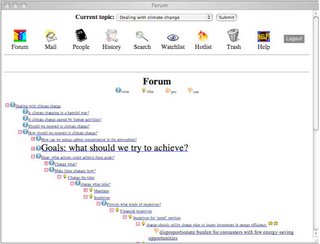An article on bringing Web 2.0 to bear on climate change caught my eye this sunny and serene Sunday am. It’s a short post on Climate Feedback presenting threaded discussion forum for use in managing debate and discussion among those interested in climate change. Conceived as an “argument tree,” here’s a summary of how it’s supposed to work:
The structure requires people to present their comments in one of four categories: issues to be addressed, options for resolving those issues, the pros in favor of various options, and the cons against them. In this way, the debate could become self-organized, making it easier for people to see what’s been said, and whether points have been supported or rebutted.
Mason Inman, for Nature Network
There’s no argument with threaded discussion as a means of conducting an exchange. And the tree format shown should work fine as a means of structuring topics. (Keeping users on topic is another, and a separate matter; a community vote or approval system might work as a check on post topicality — e.g. topical digg.)
But at a more general level, other web 2.0 tools should be able to contribute to climate change conversations. We know already that social activism has benefited from the social web. And fundraising — to wit, Obama — along with micro-funding and philanthropy have also made notable headway with the help of web 2.0 sites and tools. In the conversation space, things are a bit murky still. For example, I’ve got an ongoing interest in sites like change.org, greatnonprofits.org, razoo.com, goodtree.com and others, for their potential in shaping discourse and circulating ideas and sentiments. They offer the hope of shifting cultural dispositions in favor of conservation and ecology-minded consumerism. And insofar as they integrate or contribute to social networking sites, by providing users with green interests and green identities, they help to green affinity groups and cultural trends.
Might there be benefits, too, from twitter and conversation tools? In spreading news and alerting audiences to breaking climate change stories, for example? In shaping sentiment by making green a more visible taste or consumer preference? By demonstrating that green matters to the social media savvy crowd? And most importantly, by illustrating to big media that every week should be green week, every day should be earth day, and that the issue of climate change is not a holiday, special report, or feature, but an ever-present and persistent daily concern?
Of course, the planet’s own changing weather may change our reality sooner than we change our mentality. And at the end of the day, green branding may be seen less as a shift in opinion and more as a necessary cultural adaptation. If our practices are a reflection of our views, if what we do is a manifestation of how we talk about it, then talk technologies should indeed have something to offer.


adrian chan
March 8, 2009 at 10:20 pmtest comment